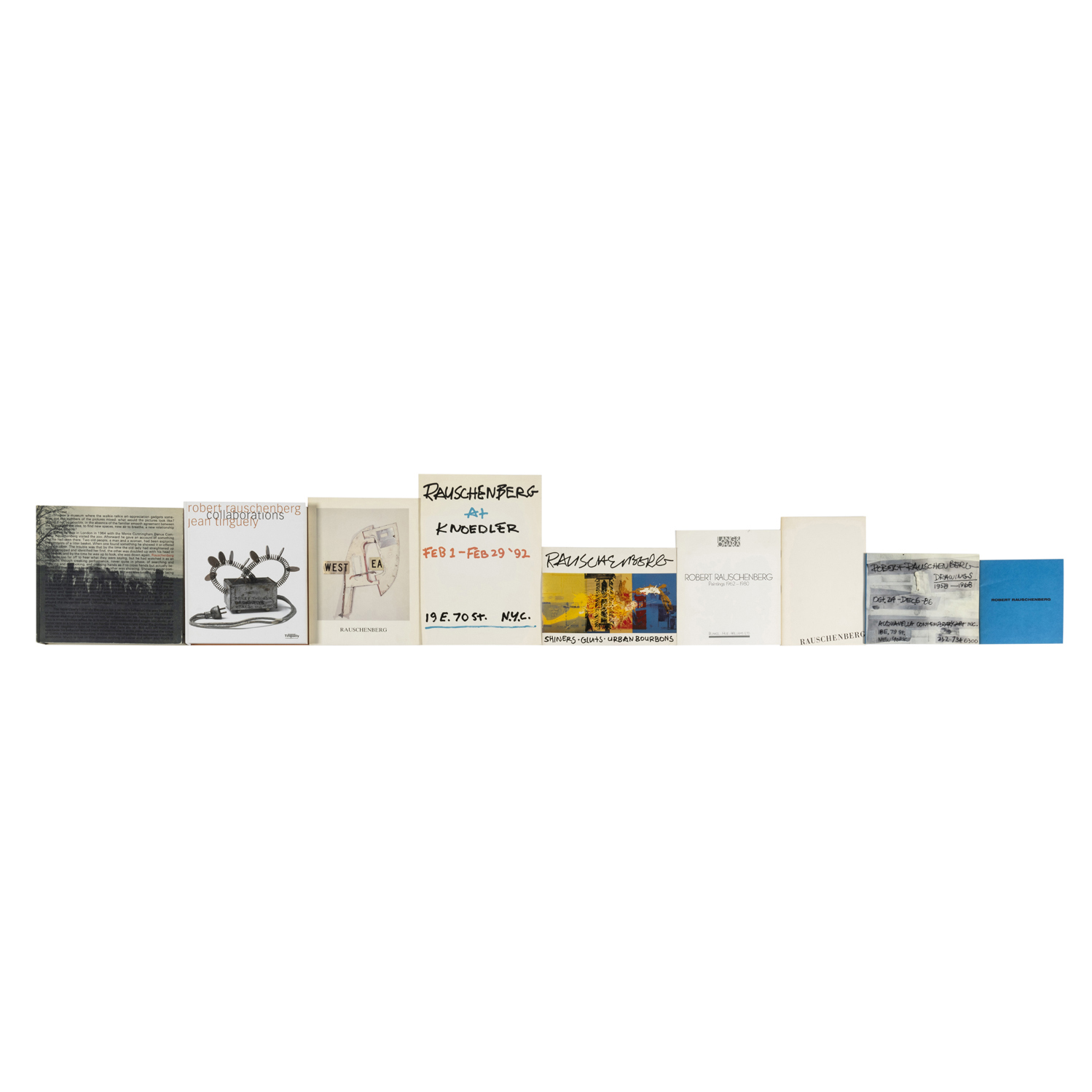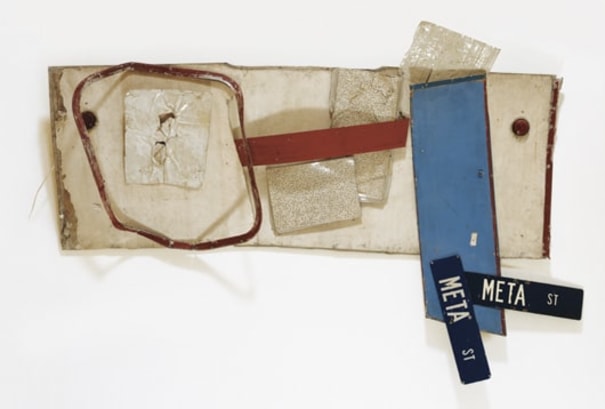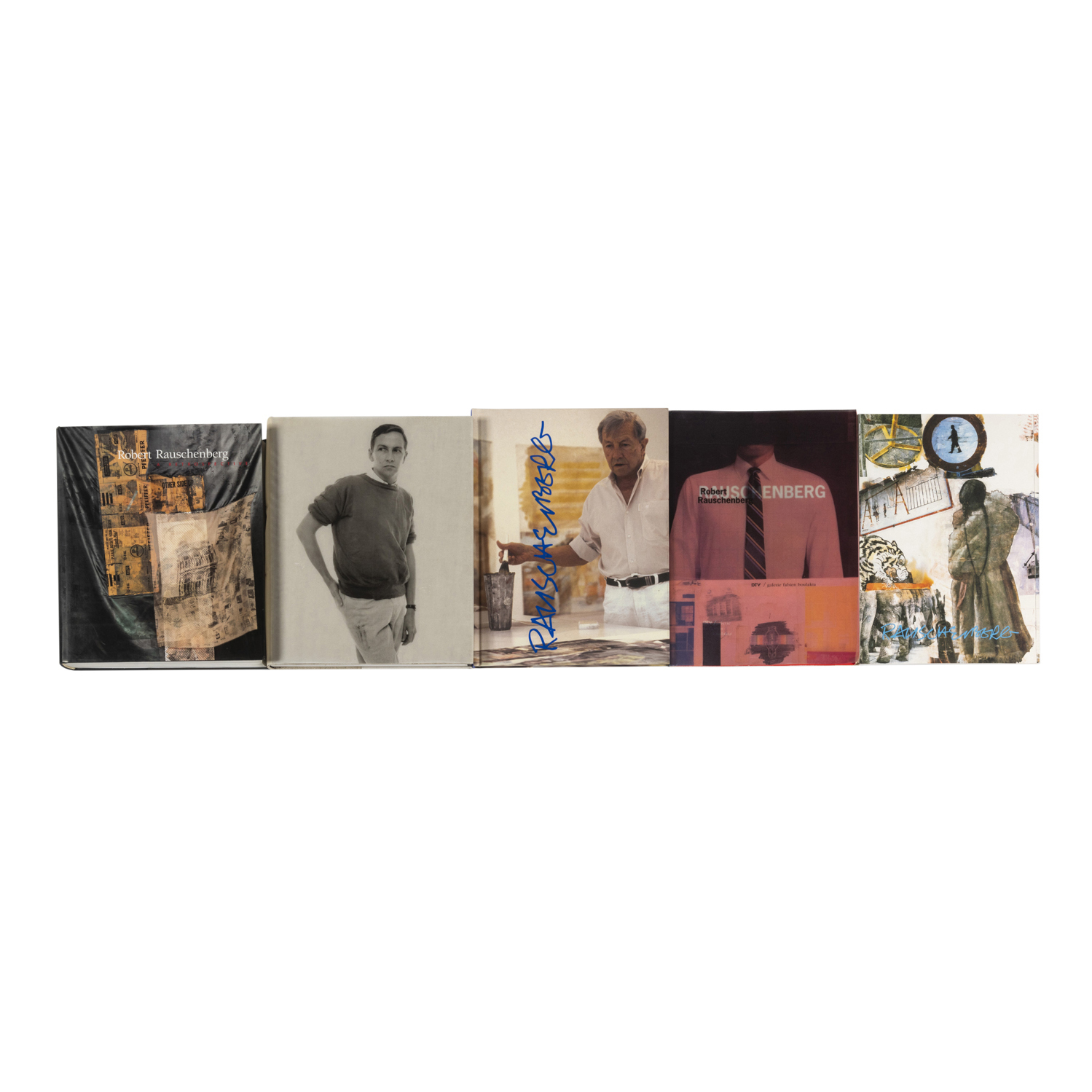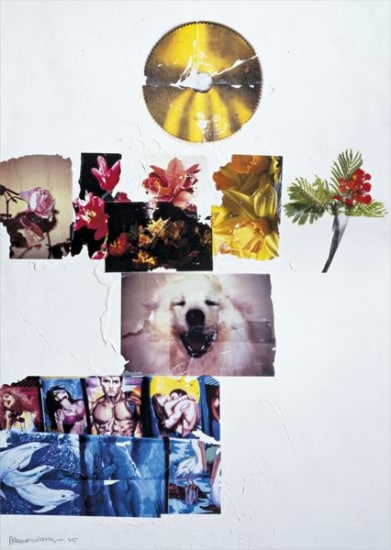Robert Rauschenberg Ruminations Series 1999 The complete set of nine etchings with photogravure in colors, on various papers, the full sheets, various sizes all signed, dated `99' and numbered 23/46 in pencil, published by Universal Limited Art Editions, West Islip, New York (with their blindstamp), all in very good condition, two framed, seven unframed.
Catalogue Essay Including: Ace; Big and Little Bullys; Bubba's Sister; Eagle Eye; Ileana; Jap; John; Tanya; and 'topher The nine Ruminations are a deeply intimate portrayal of the artist’s formative relationships, mostly from the late 1950’s and early 1960’s. The images are almost entirely drawn from Rauschenberg’s own photography. He forms a trio within a trinity. A family trio contains Big and Little Bullys, his parents, in old age as well as Port Arthur where he grew up; Bubba's Sister depicts sister Janet as a young girl and young woman; and topher pictures Rauschenberg’s former wife, Susan Weil and his son Christopher as a young child. A second trio depicts pivotal figures in the development of his art. John portrays John Cage the composer and his Model A Ford, which also played a role as the vehicle that made Rauschenberg’s first tire print. With his exploration of the boundaries of music, Cage greatly influenced the trajectory of Rauschenberg’s artistic development. Tanya depicts the pioneering ULAE founder Tatanya Grossman from whom Rauschenberg first learned to make prints (and discovered the silkscreen process that led to his breakthrough silkscreen paintings of 1962-64), as well as her husband Maurice and the house where ULAE was founded. That she is included also comments on the importance Rauschenberg placed on the print within his artistic production. Illeana depicts the legendary dealer Illeana Sonnabend, who having become acquainted with Rauschenberg through then husband and market making dealer Leo Castelli, eventually gives Rauschenberg his first major commercial show in Europe, and who having moved to Paris, helps Rauschenberg become an international figure. The final trio are all artists: Steve Paxton, the dancer appears in Ace; Cy Twombly and scenes from Rauschenberg and Twombly’s trip to Rome in the mid 1950’s appears in Eagle Eye and the mysterious Jasper Johns looks out in an intimate and simple portrait titled Jap. This last trio has a second, less well-known common thread: all were one-time lovers of Rauschenberg. Stepping back, it’s fair to ask if these prints are after all, great Rauschenbergs. They seem to be a distinct departure into direct expression, almost confessional in their revelation. That alone places them neatly in a larger story line of Rauschenberg’s constant innovation and self re-invention. But, are they too direct, lacking mystery or not prompting enough debate and consideration? By the directness that both reveals and confounds, Rauschenberg seems to be telling us after a half century of work that yes indeed, there is both intention and meaning in his work, and thereby resolving the great debate his work has spawned over the decades. Still, even in their apparent directness, it’s not entirely clear what they mean. Different viewers can and will draw different conclusions, even if more similar for these works than others that preceded them. And, the more industrious student of Rauschenberg’s life can’t help but notice that the most important written sources on his life contain conflicting dates and ‘facts’ about key elements of his personal life. Perhaps in that way, Rauschenberg has innovated and surprised again, pushing the boundaries of his own art in ways we didn’t anticipate. He shows us he can be nearly literal and revelatory and still confound. And instead of clarifying those conflicts about his life through interviews or writing, he chose his art to communicate. For these reasons, and because of their soft and somber beauty, they are indeed great, even if in a quiet way, and so appropriate and bittersweet for an artist approaching the end of a remarkable life. Stephen Dull, Ruminations on Ruminations, 2010 Read More
Robert Rauschenberg Ruminations Series 1999 The complete set of nine etchings with photogravure in colors, on various papers, the full sheets, various sizes all signed, dated `99' and numbered 23/46 in pencil, published by Universal Limited Art Editions, West Islip, New York (with their blindstamp), all in very good condition, two framed, seven unframed.
Catalogue Essay Including: Ace; Big and Little Bullys; Bubba's Sister; Eagle Eye; Ileana; Jap; John; Tanya; and 'topher The nine Ruminations are a deeply intimate portrayal of the artist’s formative relationships, mostly from the late 1950’s and early 1960’s. The images are almost entirely drawn from Rauschenberg’s own photography. He forms a trio within a trinity. A family trio contains Big and Little Bullys, his parents, in old age as well as Port Arthur where he grew up; Bubba's Sister depicts sister Janet as a young girl and young woman; and topher pictures Rauschenberg’s former wife, Susan Weil and his son Christopher as a young child. A second trio depicts pivotal figures in the development of his art. John portrays John Cage the composer and his Model A Ford, which also played a role as the vehicle that made Rauschenberg’s first tire print. With his exploration of the boundaries of music, Cage greatly influenced the trajectory of Rauschenberg’s artistic development. Tanya depicts the pioneering ULAE founder Tatanya Grossman from whom Rauschenberg first learned to make prints (and discovered the silkscreen process that led to his breakthrough silkscreen paintings of 1962-64), as well as her husband Maurice and the house where ULAE was founded. That she is included also comments on the importance Rauschenberg placed on the print within his artistic production. Illeana depicts the legendary dealer Illeana Sonnabend, who having become acquainted with Rauschenberg through then husband and market making dealer Leo Castelli, eventually gives Rauschenberg his first major commercial show in Europe, and who having moved to Paris, helps Rauschenberg become an international figure. The final trio are all artists: Steve Paxton, the dancer appears in Ace; Cy Twombly and scenes from Rauschenberg and Twombly’s trip to Rome in the mid 1950’s appears in Eagle Eye and the mysterious Jasper Johns looks out in an intimate and simple portrait titled Jap. This last trio has a second, less well-known common thread: all were one-time lovers of Rauschenberg. Stepping back, it’s fair to ask if these prints are after all, great Rauschenbergs. They seem to be a distinct departure into direct expression, almost confessional in their revelation. That alone places them neatly in a larger story line of Rauschenberg’s constant innovation and self re-invention. But, are they too direct, lacking mystery or not prompting enough debate and consideration? By the directness that both reveals and confounds, Rauschenberg seems to be telling us after a half century of work that yes indeed, there is both intention and meaning in his work, and thereby resolving the great debate his work has spawned over the decades. Still, even in their apparent directness, it’s not entirely clear what they mean. Different viewers can and will draw different conclusions, even if more similar for these works than others that preceded them. And, the more industrious student of Rauschenberg’s life can’t help but notice that the most important written sources on his life contain conflicting dates and ‘facts’ about key elements of his personal life. Perhaps in that way, Rauschenberg has innovated and surprised again, pushing the boundaries of his own art in ways we didn’t anticipate. He shows us he can be nearly literal and revelatory and still confound. And instead of clarifying those conflicts about his life through interviews or writing, he chose his art to communicate. For these reasons, and because of their soft and somber beauty, they are indeed great, even if in a quiet way, and so appropriate and bittersweet for an artist approaching the end of a remarkable life. Stephen Dull, Ruminations on Ruminations, 2010 Read More



.jpg)





.jpg)

Testen Sie LotSearch und seine Premium-Features 7 Tage - ohne Kosten!
Lassen Sie sich automatisch über neue Objekte in kommenden Auktionen benachrichtigen.
Suchauftrag anlegen